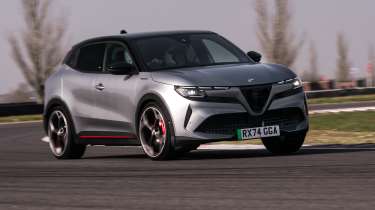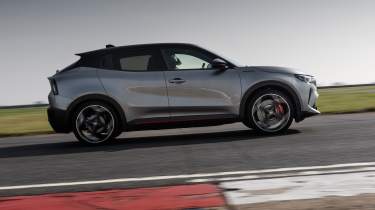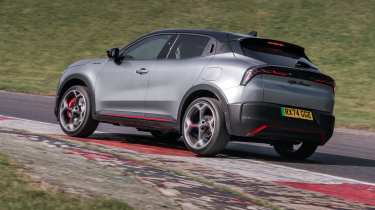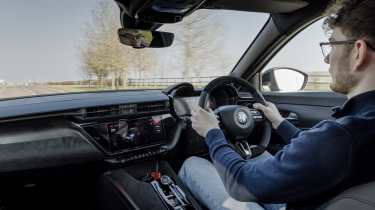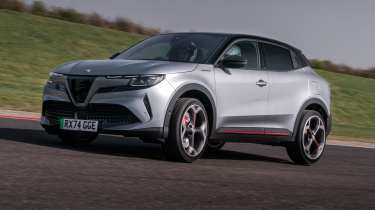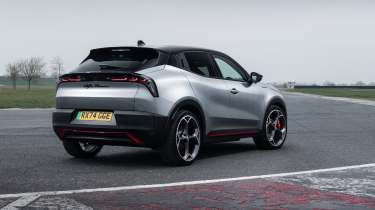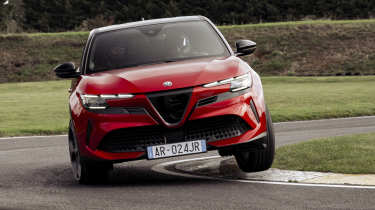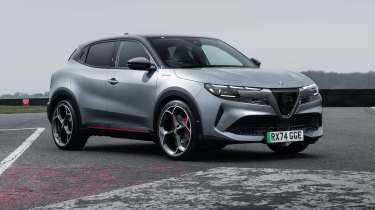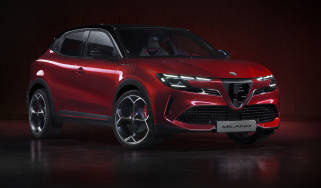Alfa Romeo Junior Veloce 2025 review – an electric crossover with hot hatch credentials
The Junior is Alfa Romeo’s first ever pure-electric model, but don’t let that put you off. The Veloce is a practical offering with a real performance edge
Underpinnings shared with the Peugeot e-2008 might lead you to believe the Junior is yet another dull crossover, but Alfa Romeo believes it has created something different with the Veloce. Launched as the marque’s very first all-electric vehicle, it plays a crucial role in kick starting its EV offensive, and on first impressions it’s set to do a very good job.
Its last-minute name change was certainly humourous and plays into the firm’s stereotype well, but this needn’t be all the model is about. Rivalling the Alpine A290 and electric Mini John Cooper Works, the Junior Veloce extracts every last drop of performance from the underlying hardware to give it credentials more in-line with a hot hatch than a crossover. It might share parts with the Abarth 600e, but it takes on a unique personality, more mature and sophisticated in-line with its Alfa badge.
> Abarth 600e 2025 review – Italy gives the Alpine A290 something to worry about
Alfa Romeo says the Junior targets Giulietta buyers and new drivers with its combination of a small footprint, sharp styling and practicality. While we can’t see the £42,295 Veloce being the usual choice for a new driver, the vision is clear. To find out if an EV can muster that trademark Alfa character, we get behind the wheel of the range-topper on UK roads.
Powertrain and technical highlights
At the core of the Alfa Romeo Junior is a 54kWh battery pack (51kWh useable), sending power to a front-mounted electric motor in both the entry-level Elettrica and Veloce – there’s also now the Junior Ibrida for those that don’t want to go electric, featuring a 134bhp 1.2-litre mild-hybrid powertrain. There’s no word yet on if a more potent all-wheel drive electric ‘Quadrifoglio’ might be in the pipeline, but if the Veloce is anything to go by, this is something we’d like to see.
The entry-level Elettrica makes do with 154bhp and 191lb ft of torque, but jump up to the Veloce and things get a little more serious. While far from the headline figures we see from some EVs in 2025, a brand new in-house developed motor develops 276bhp and 254lb ft of torque, giving the range-topper almost twice the power of the model beneath it.
While many single-motor EVs opt for rear-drive power, the Junior has to manage this increased output through the front wheels only. To manage its potency, Alfa Romeo has fitted the same Torsen limited-slip differential as used on the Abarth 600e as standard equipment on the Veloce, making this Italian pair the only front-wheel drive EVs to have this feature.
Performance and 0-62 time
Given its modest numbers, it should come as no surprise that the entry-level Elettrica isn’t the most potent of EVs. On the road, acceleration is just as smooth and instantaneous as you’d expect from an electric motor, but pull fades quickly after the 40mph mark – 0-62mph comes in a leisurely 9sec. Throttle mapping is consistent and easy to judge though, with the trademark Alfa Romeo DNA modes allowing for subtle changes in response.
Move to the Veloce and the situation is different, with almost twice the output giving it a 77bhp/ton power-to-weight advantage at 177bhp/ton. Throttle mapping is just as well judged as in the entry-level car, but the Junior now feels like a true performance model, pushing you into your seat from a roll. A 5.9sec 0-62mph time won’t break any records but does make it hot hatch quick, with a 124mph top speed some way ahead of the 93mph Elettrica. Switch to Dynamic mode and the Veloce is noticeably sharper on the throttle, allowing you to take advantage of that limited-slip differential to adjust mid-corner attitude and manage understeer on the limit, handy for tight British B-roads.
Stellantis does offer another EV with an identical powertrain in the form of the Abarth 600e, but its setup makes it a different proposition. Numbers are identical on-paper, but the lack of an external sound generator in the Alfa Romeo makes it feel more grown up, with minimal artificial cabin sound allowing you to hear the real sounds produced by the powertrain – while admittedly subtle and much less audible at higher speeds, they correspond directly to wheelspeed to give you another point of reference for traction levels, something that the synthetic sound in the Abarth doesn’t allow for.
Ride and handling
Based on the same e-CMP platform as the Jeep Avenger and Fiat 600e, the standard Junior struggles to deal with the imperfections of the Lincolnshire roads we tested it on, lurching and leaning with its 1545kg kerb weight making itself known. Spring rate is on the slow side, but even on chunky 55-profile tyres its dampers struggle to prevent smaller imperfections from entering the cabin.
Designed to be the driver’s choice of the range, the Junior Veloce drops ride height by 25mm, applies more focussed and (slightly) wider 225-section Michelin Pilot Sport EV tyres to a set of 20-inch wheels, and a host of chassis changes. The result is best in class dynamics and engagement, according to Alfa Romeo, and based on our test on some of Britain’s trickier B-roads, we agree.
While rivals such as the MG4 and Cupra Born tip the scales at c1800kg, the Junior Veloce is said to weigh 1560kg (15kg more than the standard car), one of the lowest figures in its class. A combination of this and the use of a proper mechanical limited-slip differential help make the Veloce a truly entertaining offering, with a responsive front end, good composure and driving characteristics more like a good hot hatch than an electric crossover. The front end is easy to place with the Junior inspiring confidence to push on from the get-go.
There’s enough feedback through the wheel and seat to gauge the purchase of those front tyres, but outright steering feel is lacking as in most cars of this kind – overall weight is good, though, with more substance than even some conventional combustion-powered hot hatches. Switch to dynamic mode and the controls tighten up, with increased response making it that bit more engaging.
The Abarth 600e with which it shares almost all of its underlying hardware adopts a slightly more focused setup, with its rear anti-roll bar thicker (19mm v 17mm) than the one found in the Alfa. The difference is not something you’ll notice most of the time, but build pace on an undulating back road and the Junior Veloce lacks some of the lateral control of the 600e. Regardless of this, there aren’t many rivals that do it better.
Our first drive in the Veloce was in sodden conditions on a tight karting circuit, but even then, the differential helped extract the most from the Junior’s 276bhp output, allowing for early power application and preventing the front end from washing wide. It’s considerably less reluctant to roll on turn in than the standard car despite that less aggressive anti-roll bar, and ride on Britain’s roads doesn’t suffer too much as a result – the Junior Veloce is undoubtedly firm, but hydraulic bumpstops help soften the edge over the larger bumps you’ll inevitably encounter at low speeds, with ride only improving with speed.
Keep the Veloce in its standard modes and you get a long brake pedal with spongy initial travel, making it difficult to gauge stopping power in some circumstances. As always with EVs, blending regenerative braking with friction brakes is a difficult task, so Alfa has decided to ditch this entirely in the most focussed ‘Dynamic’ mode. As in the Abarth 600e, this mode disables regenerative braking through the pedal entirely, using only hydraulic friction braking to transform pedal feel, inspiring confidence thanks to a boost in predictability.
Efficiency and running costs
The Junior Elettrica manages a WLTP combined range of 255 miles in its most efficient form, with an efficiency figure of 4.2mi/kWh recorded on our mixed 30-mile test. For perspective, the Mini Cooper Electric and Cupra Born manage claimed ranges of 249 miles and 264 miles respectively.
Alfa Romeo has said it specifically ‘chose not to overpower’ the Veloce to keep weight to a minimum, but engineers might also have had range in mind. Combining the same 54kWh (51kWh useable) battery pack as the standard car with a much more powerful 276bhp motor makes for a WLTP combined range of 215 miles, and this figure is much less in reality should you use the performance on offer – we saw efficiency of around two miles/kWh during our road test.
Interior and tech
If you’ve spent any time in a recent Stellantis product, you’ll be familiar with much of the Junior’s interior. The gear selector and various buttons and switches are all shared with models on the e-CMP platform, which should come as no surprise. The benefit of this is that they all work well and feel solid, though these elements do detract from the sense that the Junior has an identity of its own.
Build quality is strong for the most part, with touch points all reassuringly solid. This isn’t to say materials are ultra-high end, though, with the door cards built from a cheap-feeling hard plastic like in the Abarth 600e. Regardless of this, the Junior Veloce feels like an Alfa inside and is available with numerous options, unlike its Abarth relative, adding Alcantara trim, supportive Sabelt seats (something the cheaper Abarth 600e Scorpionissima gets as standard) and a more plush overall feel with the £2200 Sport pack. An optional electric sunroof (£1200) is also nice to see, elevating the Junior to a more premium position in the market.
The Junior features some unique touches inside to set it apart from the rest, with its air vents, designed to reference the four-leaf clover, tastefully backlit, and the surround for the driver’s display as a homage to twin analogue dials – as is a theme throughout the cabin, even these feature ambient lighting, with a soft light tucked within the structure to highlight the shape of the surround.
The Speciale we tested features numerous materials throughout, with a wetsuit-like material applied to the dashboard and centre console alongside satin chrome, piano black and hard plastic trim – the latter is mostly limited to the door cards. Not much changes for the Veloce, but tick the aforementioned options pack and you’ll receive more supportive sport seats in Alcantara, along with a few other touches – while the padding protrudes awkwardly into my back, these uprated seats are great in terms of lateral support.
Real buttons on the steering wheel and even a dedicated row of physical buttons and knobs for vital climate/media control functions are great to see in 2025, but the Junior does have its ergonomic quirks. The usable display area for the central infotainment is quite small, and with it mounted low in the cabin it can be a little awkward to read at times – this isn’t the case in the Abarth 600e, with the central display mounted at the top of the dash.
Alfa Romeo says the Junior can accommodate a family, and while I can (just) fit behind the driver’s seat in my ideal position, there’s not a huge amount of space. The driving position is a touch too high for my liking and while it does provide a sense of sportiness, the high scuttle won’t be for some. The Junior does feature more storage space than some offerings though, with a useable glovebox and a space under the bonnet to store charging cables (not a given in all EVs).
Design
If you’re looking for a crossover, the Junior is one of the sharpest looking on the market – designed by the team behind the stunning 33 Stradale, this shouldn’t be a surprise. In a world where most cars are larger in reality than you expect, it’s refreshing to find that the Junior feels as compact as it should.
That trademark Alfa Romeo Scudetto grille makes it instantly identifiable out on the road, with slim, aggressive headlights and a large, full width lower intake giving it some real purpose. While perhaps a little tall, the Junior looks just as sharp from the rear, with the dark rear light element part of the aero design, and a contrasting black lower section reducing visual mass.
The range-topping Veloce features the same bumpers as the entry-level model, but a 25mm drop in ride height, increase in wheel size and change to suspension geometry all combine to give it a far more purposeful appearance. The large teledial-esque wheels are striking in person, but the large openings do expose the comparatively miniscule brakes behind them.
Price and rivals
The Junior range now begins with the £27,895 Junior Ibrida hybrid, rising to £33,895 for the Elettrica EV, with the identically-powerful Elettrica Speciale commanding a small premium at £35,695 to bring more standard kit to the table. At the top of the range is our model of choice, the Veloce, with almost twice the power of the alternatives and a higher £42,295 price point.
The Abarth 600e is the Junior Veloce’s closest rival on-paper, with it boasting identical numbers and underpinnings. Despite this, the two aren’t fighting for the exact same position in this fledgling market, with the Abarth, even in range-topping Scorpionissima-form, £2420 cheaper at £39,875 – while this does mean it avoids the luxury car tax, you sacrifice standard kit, and there’s no option to improve it with the 600e essentially a no-options car. The Abarth is also unique in that it’s available with a lower 237bhp power output, retaining the same chassis setup and limited-slip differential, just with even less standard kit for £36,975.
Elsewhere in the market there’s the Cupra Born, starting from £36,475 before rising to £39,205 in its most powerful form – this car is still no match for the Veloce, though, producing 228bhp to the Alfa's 276bhp. Range is on the Cupra's side though, with the entry-level car boasting a 264-mile range and the upgraded battery variant lifting this number to 341 miles. There's also the MG4 which starts from a class-leading £26,995, but even the 429bhp XPower variant (£36,495) lacks the dynamic finesse of the Junior Veloce.
The Alpine A290 is perhaps the closest to the Junior Veloce in terms of engagement and design, but while a £36,000 starting price is less than that of the Alfa, a 217bhp peak output isn’t enough to compete. The 254bhp Mini John Cooper Works Electric gets a little closer for £38,420, but we’re yet to test it for ourselves.
Alfa Romeo Junior specs
| Veloce | Elettrica/Elettrica Speciale | |
| Powertrain | Single-motor, front-wheel drive | Single-motor, front-wheel drive |
| Power | 276bhp | 154bhp |
| Torque | 254lb ft | 191lb ft |
| Weight (inc driver) | 1560kg | 1545kg |
| Power-to-weight | 177bhp/ton | 100bhp/ton |
| 0-62mph | 5.9sec | 9sec |
| Top speed | 124mph | 93mph |
| Range (WLTP combined) | TBC | 255 miles |
| Price | £42,295 | £33,895 |
